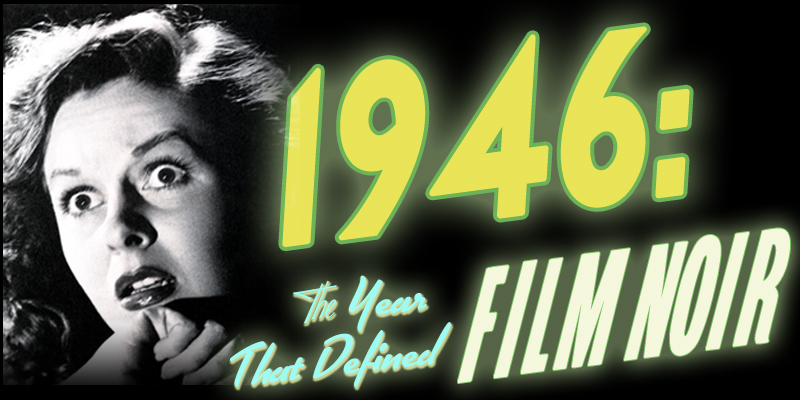
NOIR LINKS
10 Shades Of Noir
Back Alley Noir
Classic Noir Online
Dr. Noir's Crime Posters
AMC Film Noir
Film Noir Foundation
The Dark Room
Noir of the Week
Noircast.net
Film Noir Alley
Noir City
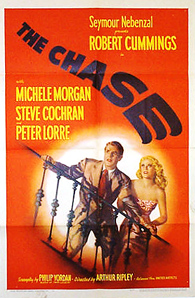 Adapted for the screen from Cornell Woolrich's pulp novel The Black Path Of Fear, The Chase is a nightmarish fever-dream containing some of the most
arresting - and blackest - cinematography in all of film noir.
Adapted for the screen from Cornell Woolrich's pulp novel The Black Path Of Fear, The Chase is a nightmarish fever-dream containing some of the most
arresting - and blackest - cinematography in all of film noir.
Befitting its pulp origins, The Chase was a B-production with a cast of mostly second-rank stars, but including noir icon Peter Lorre as
the sneering, chain-smoking henchman of Eddie Roman, a brutal Miami gangster. Typical of a Woolrich yarn, The Chase's storyline is propelled
by the blind, indifferent fist of fate in leaving Robert Cummings, as Chuck Scott - another battle-shocked, down-and-out veteran, of course - with the
chance find of a lost wallet. The wallet belongs to Roman, and an ill-advised trip to Roman's mansion to return the wallet lands Scott a job as Roman's
chauffeur, following a memorable hazing session with Lorre and Steve Cochran, as Roman.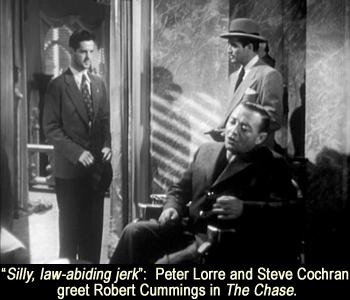
Before long, Scott is spinning along the seaside on nightly moonlight drives with Roman's glamorous wife Lorna. She's an exotic flower who for some reason has become
disillusioned with life at Roman's side, perhaps due to some of Roman's quirky habits. When he's not slapping around the hired help or watching his
dog maul his business rivals to death, Roman likes to indulge his own death-wish by using his car to play chicken with speeding passenger trains.
In their final midnight tryst, Scott and Lorna make plans to escape the next day by steamship to Havana, whereupon The Chase splinters into
a convoluted series of dream sequences and outlandish plot twists. It's not quite clear until the final reel what's real and what's a product of Scott's
disturbed psyche, a souvenir of military service that leaves him prone to amnesiac fevers and blackouts.
Regardless, the centerpiece of the film is the infernal, expressionistic depiction of Havana crafted by director Arthur Ripley and diretor of photography
Franz Planer. A refugee from Nazi Germany, Planer like many continental expat Hollywood technicians cut his teeth on some of the classics of Weimar
German silent cinema during the 1920s, and by the 1940s had established himself as a Hollywood journeyman. His Havana is a claustrophobic bedlam of
ominous shadows and furtive killers, a far cry from the exotic, sun-splashed playground that audiences of the 1940s were used to seeing. The illumination
of some of the Havana shots is so dim that it seems to bear out Robert Mitchum's famous observation that "Cary Grant and all the big stars got all the
lights. We lit our sets with cigarette butts."
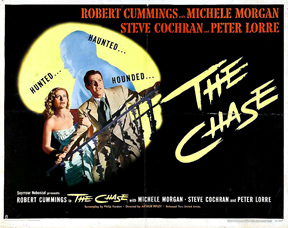 It's bravura visual style aside, whether The Chase is
anything more than "a chaotic botch" of a film, as Woolrich's biographer Francis Nevins contends, depends on a viewer's ability to set aside narrative
consistency and surrender to the nightmarish illogic of the film's dream-like atmosphere.
It's bravura visual style aside, whether The Chase is
anything more than "a chaotic botch" of a film, as Woolrich's biographer Francis Nevins contends, depends on a viewer's ability to set aside narrative
consistency and surrender to the nightmarish illogic of the film's dream-like atmosphere.
The contrivance of having a good portion of the film framed by dream sequences or flashbacks
is, of course, one of the hallmarks of film noir, and one that was re-energized in the immediate post-war period by the stock figure of the war-damaged veteran.
This lends The Chase an almost hallucinatory quality in places. In concert with the doom-laden premises of The Chase's source material, the oneiric components of the film help it attain its own uniquely dark distinction in the annals of film noir.
According to film historian Robert Porfirio, The Chase is "the best cinematic equivalent of the dark, oppressive atmosphere that characterizes
most of Cornell Woolrich's best fiction."
Probably no literary figure is more associated with the sinister allure of film noir than Cornell Woolrich, and probably no writer of major distinction lived
more of a life that seemed ripped from the lurid pages of a noir screenplay.
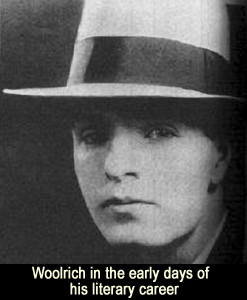 Although he started out in life as a Jazz Age golden boy with aspirations of becoming the next F. Scott Fitzgerald,
Woolrich by the late 1930's had managed only the stature of one of the leading lights of the burgeoning pulp fiction industry. Like his fellow pulp colossus H.P. Lovecraft,
Woolrich dealt in cosmic horror, though his brand of terror dealt more with the workings of implacable Fate in an indifferent universe instead of the vastly
ancient and malignant supernatural forces of Lovecraft's fiction.
Although he started out in life as a Jazz Age golden boy with aspirations of becoming the next F. Scott Fitzgerald,
Woolrich by the late 1930's had managed only the stature of one of the leading lights of the burgeoning pulp fiction industry. Like his fellow pulp colossus H.P. Lovecraft,
Woolrich dealt in cosmic horror, though his brand of terror dealt more with the workings of implacable Fate in an indifferent universe instead of the vastly
ancient and malignant supernatural forces of Lovecraft's fiction.
But the quality and novelty of Woolrich's work before long attracted the attention of Hollywood, and film treatments of Woolrich stories had become
commonplace - and a lucrative source of income for Woolrich - by the early 1940s.
By the end of World War Two, no less than four Woolrich yarns had been developed into major feature films, and he was a hot property heading into
1946 with an additional three projects in development. Each of these - Deadline At Dawn, The Black Angel, and The Chase - found
their way into theaters and critical acclaim during that pivotal year.
Woolrich went on to contribute the source material for seven more productions before the decade was out, culminating in the film that many - including his
biographer Nevins - believe to be his pinnacle of achievement during the 1940s, 1949's RKO production The Window.
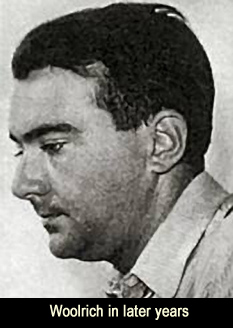 Film work began drying up for Woolrich in the 1950s, displaced by the new medium of television and an overall zeitgeist that was somewhat less
receptive to the fraught and weirdly melodramatic themes of his fiction. Nonetheless, Woolrich-originated material became the basis of numerous teleplays
during the new era, and Woolrich did manage to vault into the big-budget, blockbuster stratosphere with Alfred Hitchcock's 1954 producton Rear Window.
Film work began drying up for Woolrich in the 1950s, displaced by the new medium of television and an overall zeitgeist that was somewhat less
receptive to the fraught and weirdly melodramatic themes of his fiction. Nonetheless, Woolrich-originated material became the basis of numerous teleplays
during the new era, and Woolrich did manage to vault into the big-budget, blockbuster stratosphere with Alfred Hitchcock's 1954 producton Rear Window.
Although Woolrich encountered considerable financial and professional success throughout his life, his personal circumstances were dismal until the
very end. Tormented by the downbeat cast of his personality and his homosexuality, Woolrich lived most of his life with his mother in a series of slum-like
tenement buildings and residential hotels. He died alone in 1968 as an alcoholic, gangrenous wreck, unmourned as a man but as a writer acclaimed as
"the Poe of the twentieth century and the poet of its shadows," as his biographer Nevins put it.
Given these posthumous accolades, it's regrettable that Woolrich's fiction is today only intermittently and sporadically available, and that many of his
key works exist only in libraries and in scalped online auctions. Some editions still circulate and can be sourced from the usual suspects like Amazon
and Chapters in Canada, but the pickings are woefully slim.